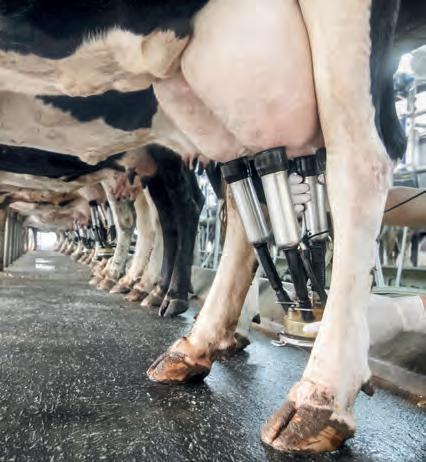
3 minute read
Fidgety cows point to increased mastitis risk
Spring can produce a peak in mastitis due to environmental challenges at calving, but as you move further through the season the incidence of mastitis should reduce, along with the bulk tank somatic cell count. If mastitis incidence does not decline, factors around shed and teat spray function could be at play.
It is commonplace to have the shed checked by a milking technician during the winter but this does not identify all issues. The cows are a great indicator of shed issues so take some time to look at them. Observe how comfortable they are in the shed, or if they are kicking or fidgety. How quickly do they let their milk down after cups on, or is there a delay either at cups on or after a short let-down? Do the udders look evenly milked out at the end of milking? Any anomalies here can point to shed function issues. Also take time to look at teat ends and teat condition. Turning over teats and inspecting the ends can be a useful indicator of shed function. The early stages of teat end damage are reflected in thickened teat ends with minor cracking, which can be subtle. As the teat end damage worsens this can show more obvious crusting and thickening. Other signs to look for at milking time are ringing at the base of the teat end or pinpoint red spots, along with bluish teats. All these point to an issue with the shed, such as high vacuum, incorrect pulsation, unsuitable liners, dry teats and overmilking and should be addressed. Failure to rectify will see an increase in mastitis. The teats should be supple, smooth and crack-free. Aside from looking unsightly, cracked teats harbour bacteria and are uncomfortable for the cow. If more than 10 percent of the herd have cracked teats, then the teat spray system and environmental factors should be reviewed. Correct teat spray coverage will help improve teat condition and ensure the teat end is protected from bacteria, along with offering healing of the teat ends if there is damage. All four teats should be fully covered with spray (fronts included), with a drip on the end of the teat. Adding Donaghys Glycerine or Emolan will aid in the recovery of cracked teats and damaged teat ends. Observe auto-sprayers at every milking to ensure they are working and then every week or so fully assess teat spray coverage (as outlined above). Observe at least 50 cows during this process. You may find that some bails are being missed or cups sprayed when the cow is still milking. This may indicate that the sensors are not working properly or the tension bars are not correctly positioned. Ensure these are rectified. The same principles apply for manual spraying. Use a teat spray concentration that is appropriate for your level of mastitis risk and the time of year. While it can be tempting to drop back the rate as the season progresses, think about herd level risk factors such as mastitis incidence rate, teat condition and teat end damage, along with the environmental challenge, to determine if dropping the rate is appropriate. Make a fresh batch of teat spray every 2-3 days and use 20ml per cow per milking for manual spraying and higher for auto sprayers. Ideally liners should be changed every 2500 milkings so have a system to ensure this happens. Using the liners past this time will compromise the milking system and teat health. Ensure the liner you have is appropriate for your cows and shed. An incorrect liner is a common cause of teat end damage. Donaghys has an excellent selection of liners, teat sprays and emollients. Speak to your local Farmlands or Donaghys TFO for ways they can help your herd perform at its best.
| Observe how comfortable the cows are in the shed, or if they are kicking or fidgety.
For further information, contact your Farmlands Technical Field Officer or the friendly team at your local Farmlands store.
Article supplied by Donaghys
Don’t let docks and weeds control you!




Control docks and other broadleaf weeds in one hit with Dockstar® and Baton® 800WSG. Left unchecked, these weeds can create pasture suppression this spring.
Available in selected Farmlands stores.










